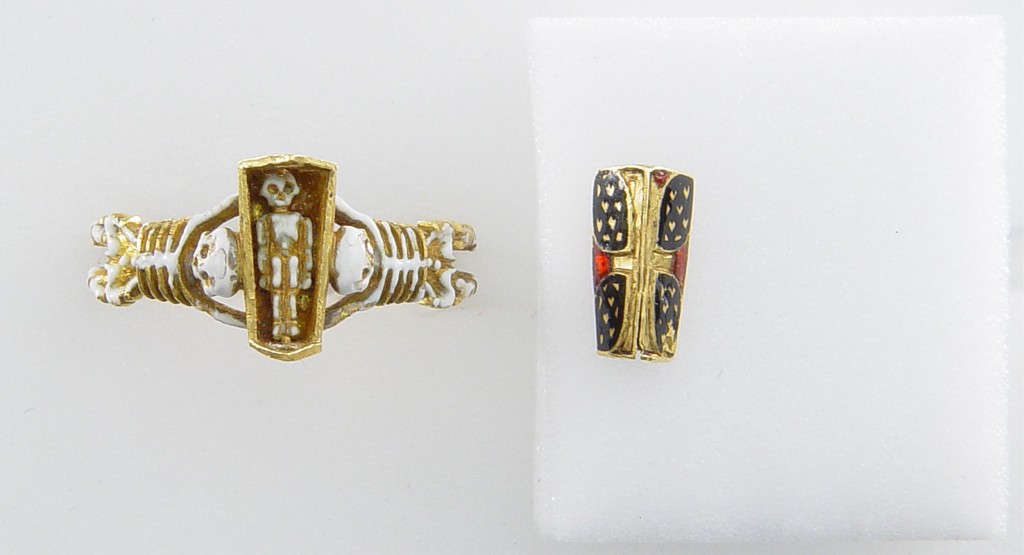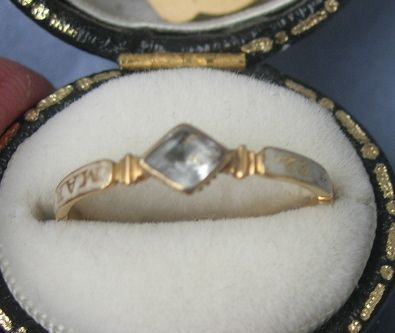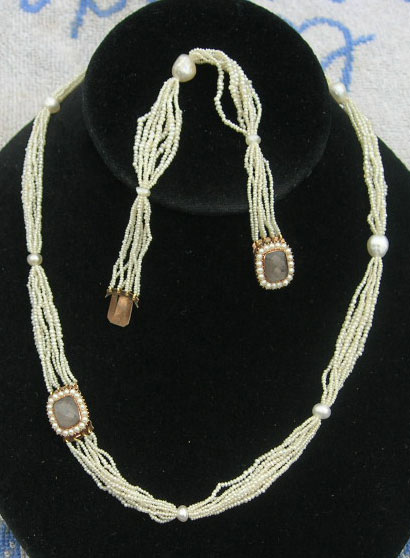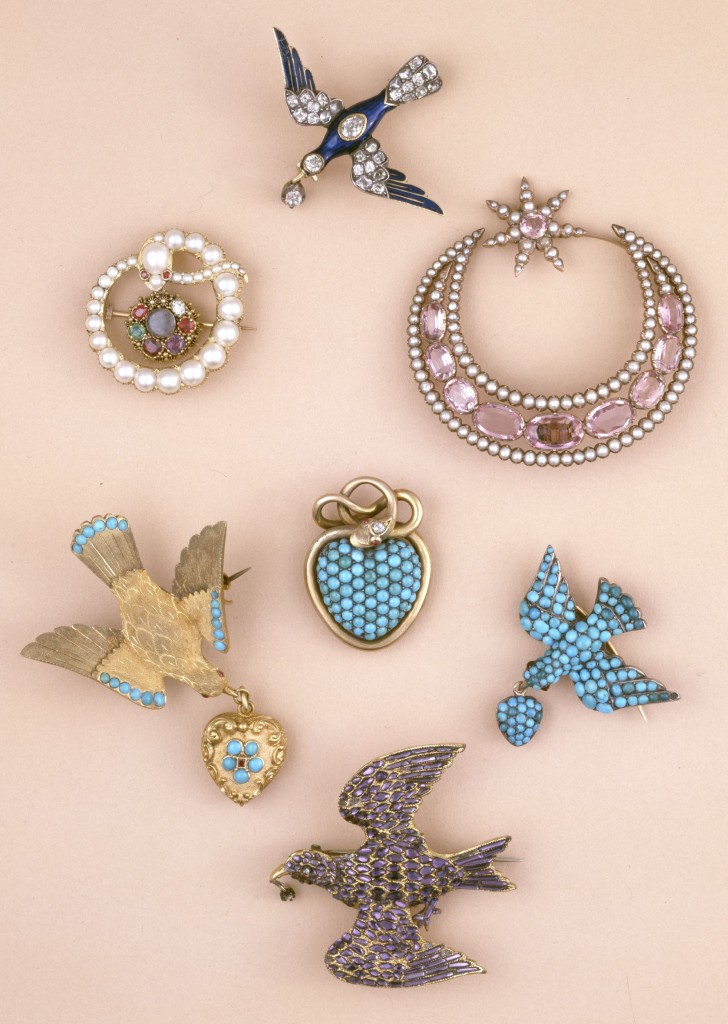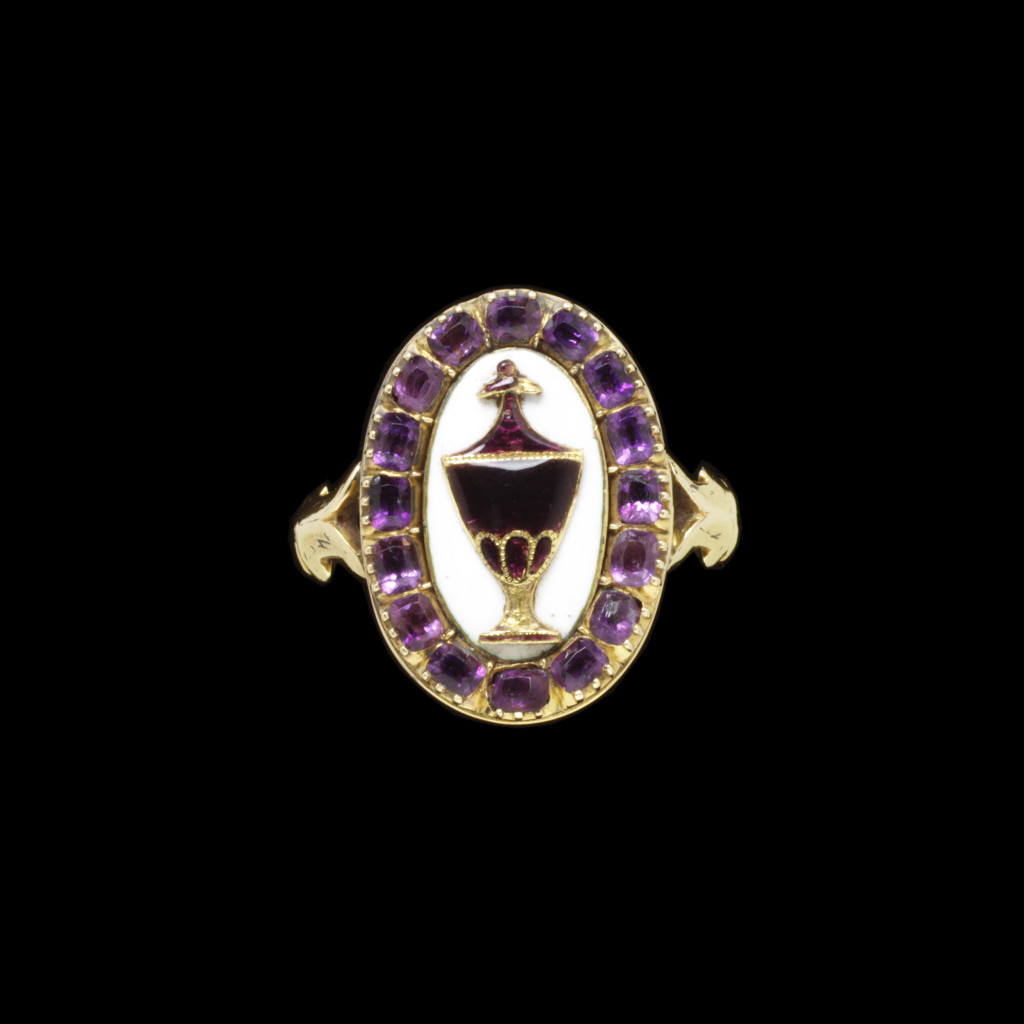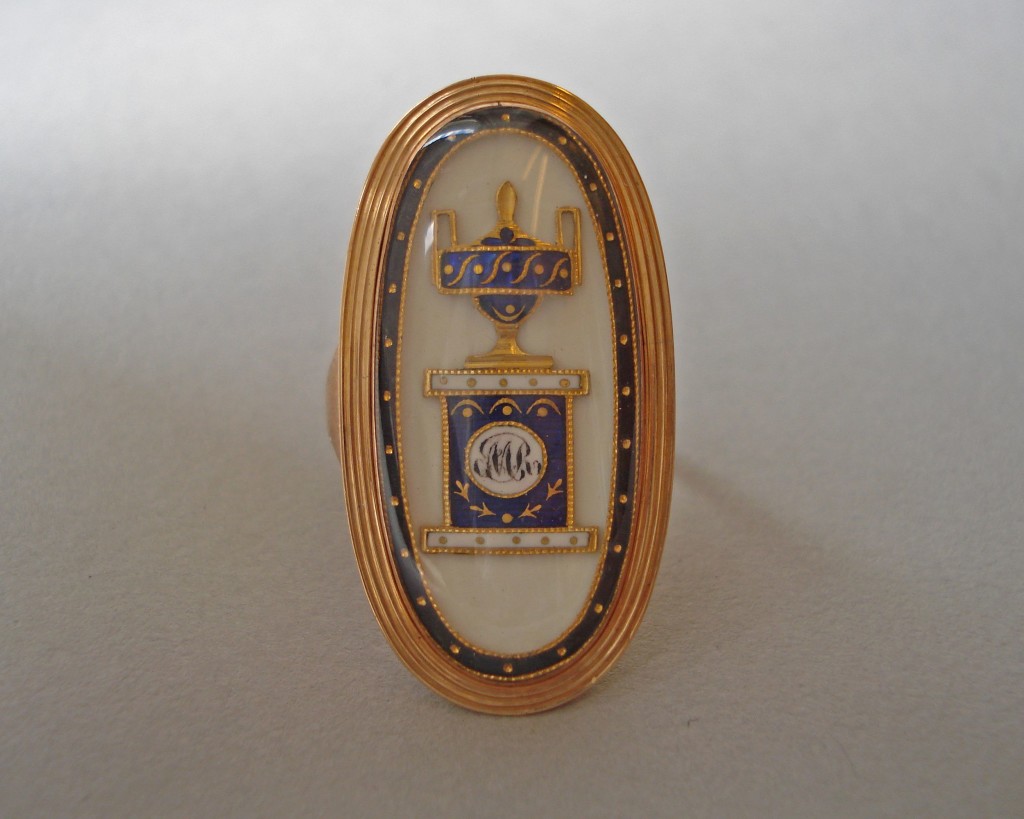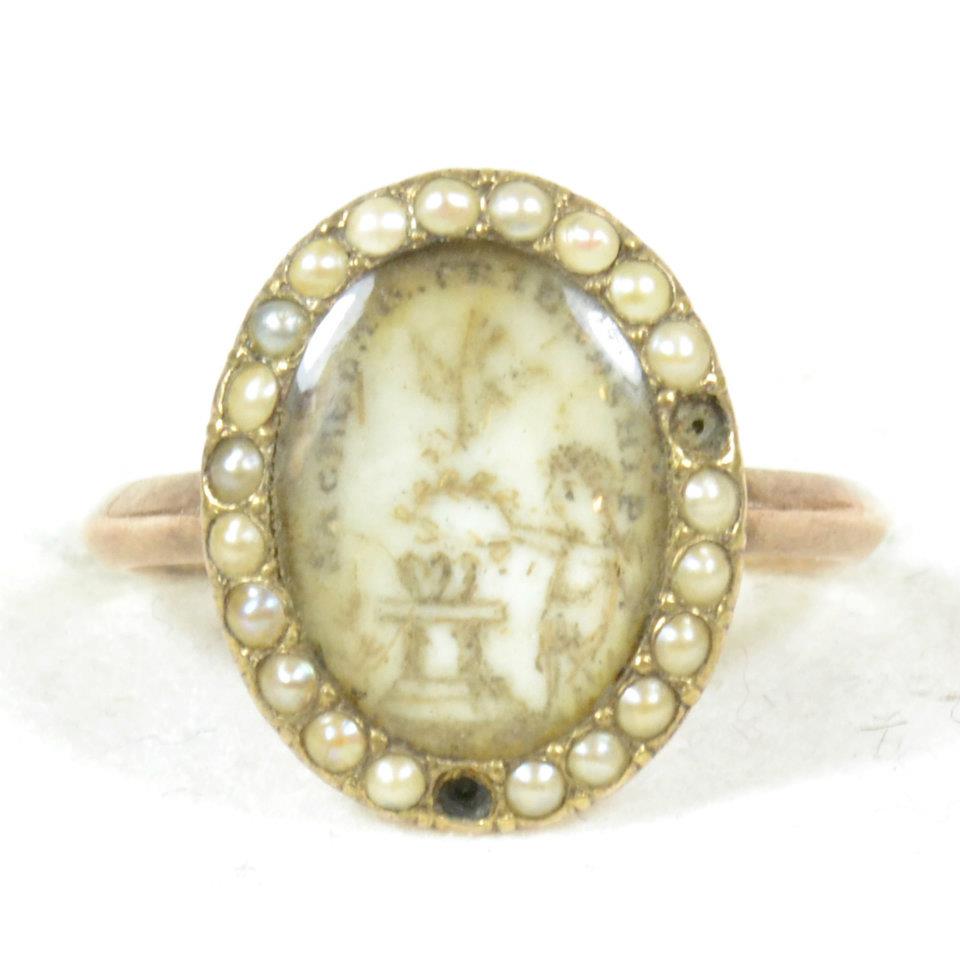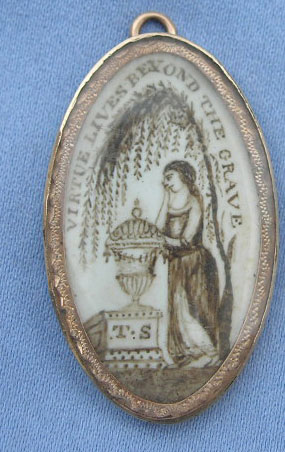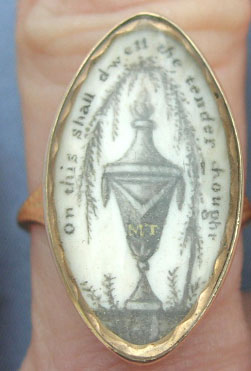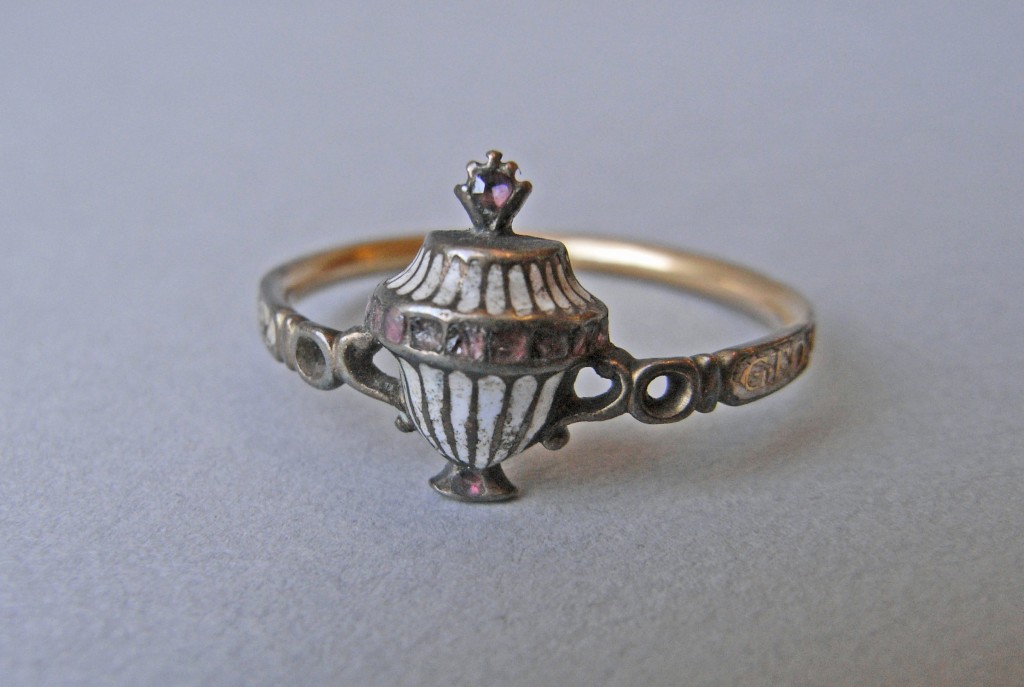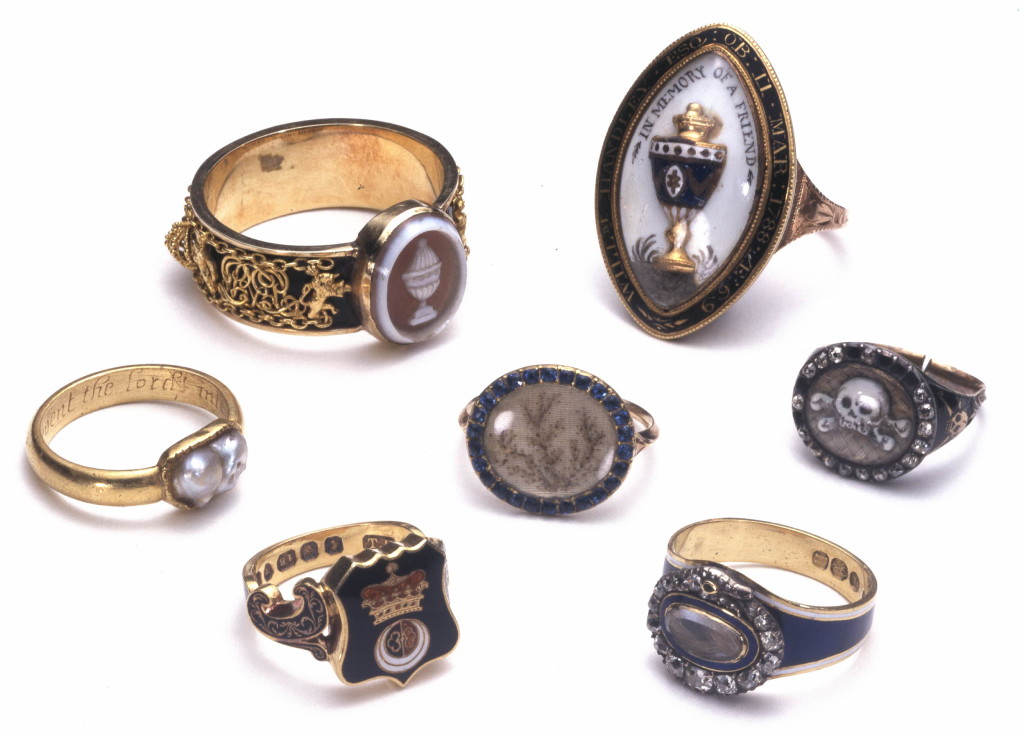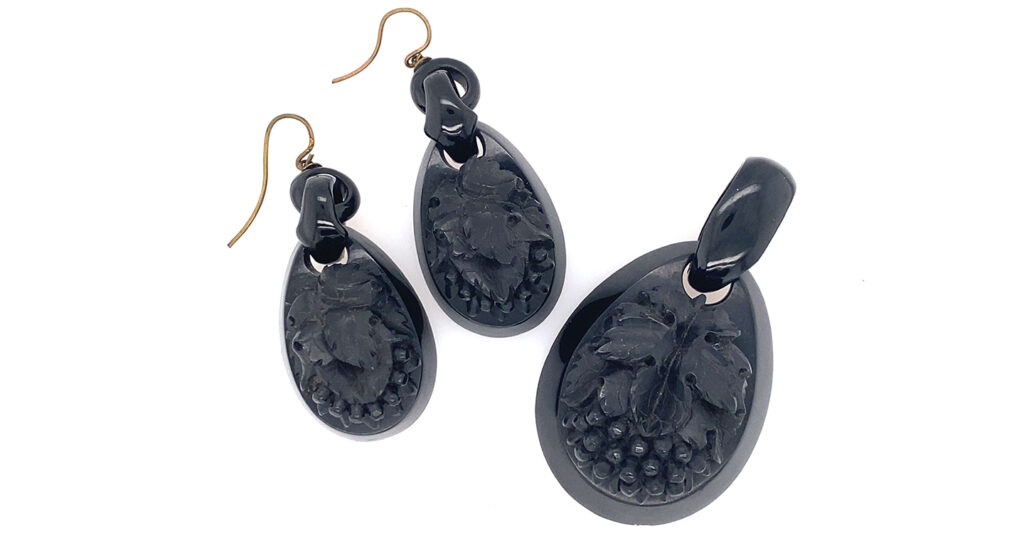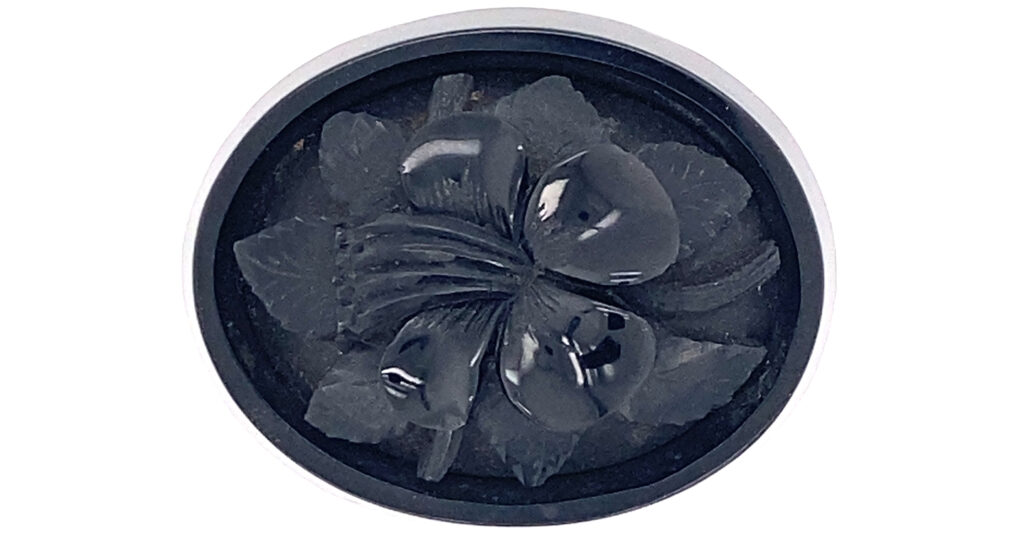Mourning Fashion & Jewels During George III
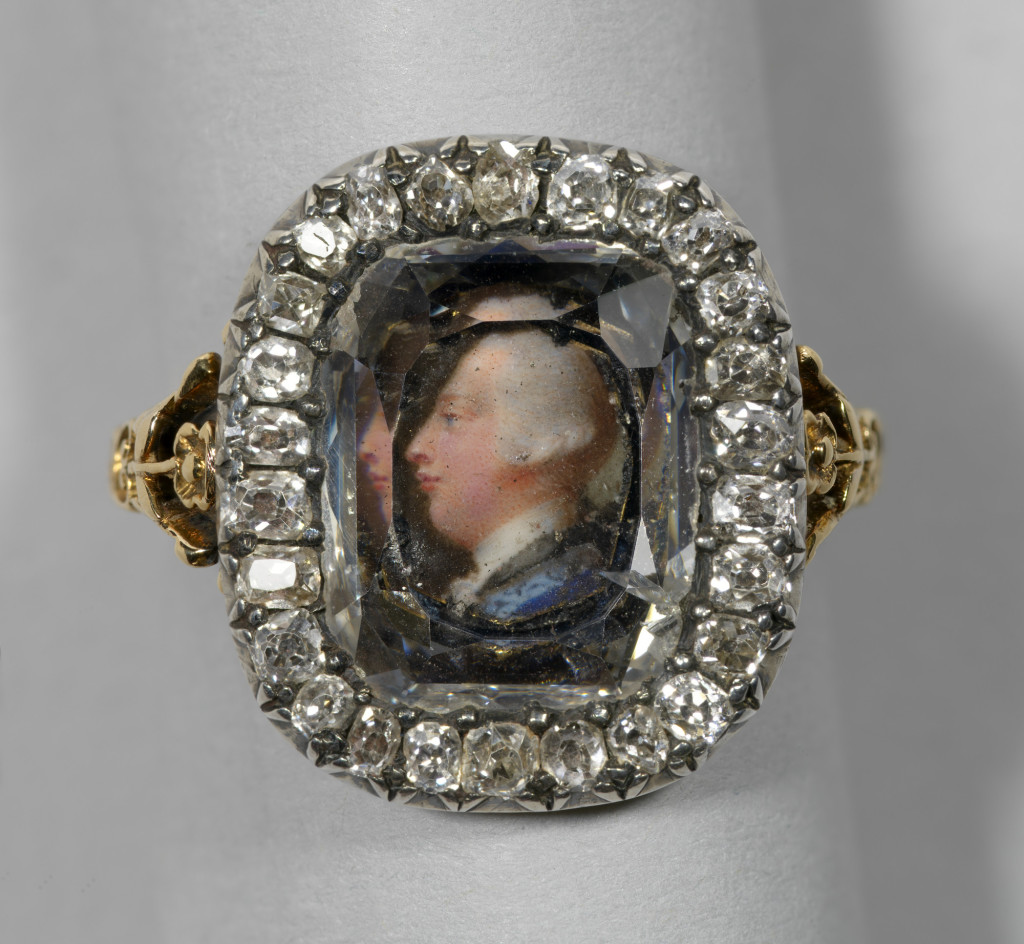
Under the reign of George III (25th of October, 1760 – 29th of January, 1820), mourning jewellery and fashion was solidified in its use of symbols, design and construction. Massive change on a global scale created new cultural identities that formed from colonies and their independence, which required new interpretations of memorial fashion.
Born in London on the 4th of June, 1738, George William Frederick provided the solidarity in his reign that George I and II did not gather. Being the new reign of the House of Hanover, much time was spent between Germany and England under George I, while George II added more legitimacy to the reign (both under constant challenge from the Jacobites and the previous House of Stuart). George III’s reign was over 59 years, being the longest of its time. For a monarch to have this level of relative internal stability and the ability to face campaigns in France, Africa, Asia and the Americas, solidarity in the United Kingdom was necessary.

George was married Charlotte of Mecklenburg-Strelitz on the 8th of September, 1761 and maintained his faith to her, unlike other male members of his family. George was a religious man, maintaining the Anglican faith, which only made him more endearing as a popular figurehead for the Kingdom. The couple had 15 children (six daughter and nine sons), buying Buckingham House (now Palace) as the family retreat.
In the Royal Marriages Act of 1772, George allowed for members of the Royal Family to only marry with the consent of the sovereign, following his brother’s adultery. This would be seen as presenting issue that could be contentious to the crown, so the Act only enforced solidarity of the crown and appealed to the religious values.
The beginning of George’s reign was met with financial instability and perception over his preference of the Tories over the Whigs. Crown debts at the time accrued to £3 million, a factor that would become a common theme during his reign. Taxation would lead to the American succession, as the British felt that the colonists needed to pay for colonial protection, yet the Americans hadn’t the representation to support or reject taxation. Internally, England was seeing further contention to parliamentary rule, leading to changing governments.
In 1773, the Boston Tea Party became the catalyst that motivated the growing discontent in America. Colonists threw the tea overboard, leading Prime Minister Lord North to shut down the port of Boston and that the Massachusetts upper house was to be appointed by the Crown, rather than elected by the lower house. Known as the ‘Intolerable Acts’ by colonists, the subsequent American War of Independence gave the colonists a figurehead to rally against and George’s perception by the public was formed. By 1776, the Declaration of Independence was drafted and support for the United States of America came from France (1778), Spain and the Dutch Republic. While there remained loyalists, defeats through to 1780 put great strain on the Crown. George drafted an abdication letter in 1784, which would have him retired to Hanover, but the speech was not given. The Treaties of Paris (1782/83) acknowledged the independence of America (returning Florida to Spain) and in 1785, John Adams became the American Minister to London.
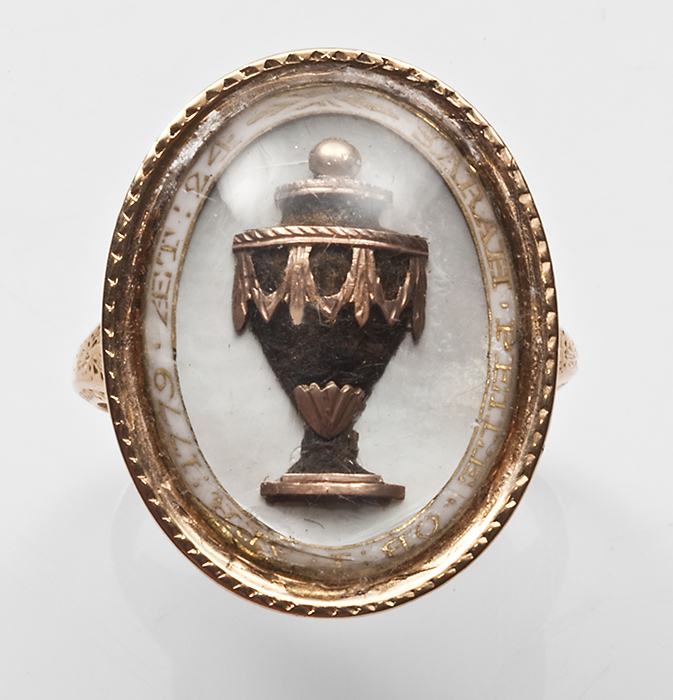
Amidst political turmoil in the early 1780s, the election of William Pitt the Younger saw a new solidarity and support of George in the public eye. In 1789, the French revolution gave way to mass destabilisation in Europe, with the gems and gold taken from the Terror being sold and dropping the value drastically. This led to many jewels of the time being more ornate in their use of gems and the sentimental value of their representation took on more symbolic meanings. Emigration into England gave the French aristocracy a haven from the revolution. George’s health began to decline from this time, with more power being held by parliament, leading to greater leniency towards Catholics, which went against George’s values. War with France began in 1793 and in 1803, the Napoleonic Wars would consume his later life.
With his health in serious decline, George III acknowledged the need for the Regency Act in May 1811, which gave power to the Prince of Wales, who then became the Prince Regent.

Through the political landscape of George’s rule, the jewels and fashions of the time become clear. Massive destabilisation and transcontinental led to artists establishing themselves in new countries and new territories demanding their own visual identity. Within the United Kingdom, the Royal Family was looked towards for the purposes of sentimentality and mourning. Holding these traditions tight meant to take them around the world, be it for the soldier taking a keepsake or emigration to a colony.
George’s family is an important study of what jewels took on the popular motifs and symbols of the time. By looking to the deaths of Amelia and Albert, along with the jewels these events produced, a narrative of mourning jewellery design and its evolution through the 18th century can be seen.
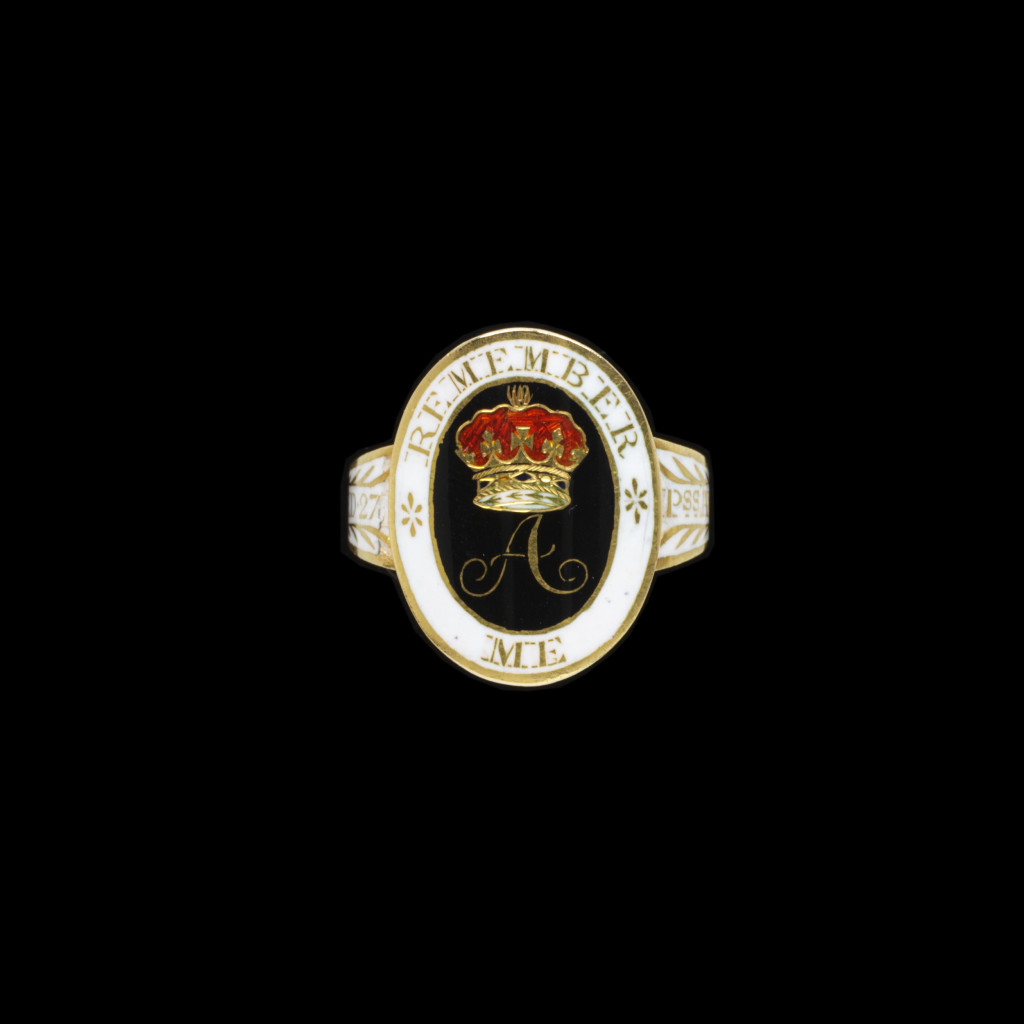
Princess Amelia (7th August 1783 – 2nd November 1810) was the youngest daughter of King George III of the United Kingdom and his queen consort Charlotte of Mecklenburg-Strelitz. George III’s family is one of the reportedly direct influences on his mental health that declined throughout his latter years. For an understanding of the average age of mortality of George III’s children, the following range of mortality is shown:
Prince Alfred (22 September 1780 – 20 August 1782; died aged 23 months)
Prince Octavius (23 February 1779 – 3 May 1783; died aged 4)
Princess Amelia (7 August 1783 – 2 November 1810; died aged 27)
Prince Edward, Duke of Kent and Strathearn (2 November 1767 – 23 January 1820; died aged 52)
Charlotte, Princess Royal (29 September 1766 – 6 October 1828; died aged 62)
Prince Frederick, Duke of York and Albany (16 August 1763 – 5 January 1827; died aged 63)
King George IV of the United Kingdom and Hanover (12 August 1762 – 26 June 1830; died aged 67)
Princess Elizabeth (22 May 1770 – 10 January 1840; died aged 69)
Princess Sophia (3 November 1777 – 27 May 1848; died aged 70)
King William IV of the United Kingdom and Hanover (21 August 1765 – 20 June 1837; died aged 71)
Princess Augusta Sophia (8 November 1768 – 22 September 1840; died aged 71)
Prince Adolphus, Duke of Cambridge (24 February 1774 – 8 July 1850; died aged 76)
King Ernest Augustus I of Hanover (5 June 1771 – 18 November 1851; died aged 80)
Prince Augustus Frederick, Duke of Sussex (27 January 1773 – 22 April 1843; died aged 80)
Princess Mary, Duchess of Gloucester and Edinburgh (25 April 1776 – 30 April 1857; died aged 81)
These aren’t chronological, but the order of age. Considering that George died on the 29th of January, 1820, this is enough to see four of his children pass away, with the youngest two boys said to have affected his mental health the most. What this shows is the behaviour of a father who loves his family and is at the mercy of his kingdom and its reach. During his reign, there was the loss of the American colonies, the French Revolution/Terror and the Napoleonic Wars; major events that could have led to mass destabilisation of Britain, and also a good indicator of what led to aggressive colonisation for global footprint.
![Portraits of their majesties, George III and Queen Charlotte, and the Royal Family visiting the Exhibition of the Royal Academy, 1788. Based on the same painting by Ramberg as Martini's engraving [E.3648-1923].](https://artofmourning.com/wp-content/uploads/2015/02/2013GU1794-1024x768.jpg)
Being a parent and outliving a child is one of the most unnatural of occurrences that can happen emotionally or biologically. Procreating, or the need to, is within biology, yet the emotion that is connected to it is inherent to the very nature of wanting to. George, being a father, loved his children. Certainly, there was the necessity of the monarchy to generate a lineage, but this should not devalue the individual as a father. Amelia’s death weighed heavily on the crown, even though he still had further family, George was highly affected by the death of his daughter.
“THE KING’S CONDITION SELECTS THE ANTHEM FUNERAL BY TORCHLIGHT ACCOUNT OF THE CEREMONY FEELING THROUGHOUT THE COUNTRY ELEGIES ON THE PRINCESS DEATH OF MARY ANNE GASKOIN HER EPITAPH.
IT was remarked by the King’s physicians that when he had become a prey to insanity the name of his daughter Amelia ceased to pass his lips. At first, however, he occasionally had fleeting intervals of comparative calm and reason. Four days before her death he was overheard holding a conversation with himself, the subject being the several causes of each of the mental illnesses from which he had suffered in past years. ” This” he said, speaking of his present malady, “was occasioned by poor Amelia.”” – The romance of Princess Amelia, daughter of George III (1783-1810) including extracts from private and unpublished papers
What is most affecting about Amelia’s death is the proximity of George to her and how this reflected in the fashion of her death. It wasn’t so simple as to have a ring produced for a person who had passed as a token of care, but this was a ring made from the very nature of love and grievance. Even in its very wording, “REMEMBER ME”, the ring speaks volumes of Amelia under the crown. It is a direct message from the wearer to the viewer to remember Amelia and that is the true aspect of how her death affected the people surrounding the crown. More so, these rings were created in a set of 52. Commissioned by the Prince Regent, later George IV, to mark her life, her brother marked her memory in a way of respect and entitlement that goes beyond formality.
The white enamel in the jewel is a mark of respect that denotes a lady whom has not been married before death. White enamel is the second most popular mourning material used, next to black enamel. Black enamel, being a colour that has represented death through to pre-history, was (and still is), the colour that was inlaid in jewels, most commonly with the ‘IN MEMORY OF’ sentiment. This was highly standardised by the 19th century, but in the 18th, there was much more flexibility with the use of sentiment and enamel colour.
What was common was the white enamel. Death, for its reasons of desecration and entrance into entropy, lead towards black, which in itself, is the absence of light. White, when in use, is the connection to purity, innocence and virginity, show the untarnished representation in colour towards a person’s morals and values. A young person who was not married was seen as unblemished in social status and the use of the white enamel to show this virtue is why white enamel is used in this context.
This ring shows nothing more than the sentiment of the person in the value of the name, which is extraordinary, when connected to jewels that show the name with a sentiment on the interior or exterior. White enamel, being more of a bespoke material, is something which can be seen as a personalised element in rings and bands. This ring shows that the style was indoctrinated through the following bands:
By the 1730s, we see the elements of white enamel and the band together. The use of the name and the date denote the death of the unmarried, and hence “pure” person was memorialised through the basic band in the white decoration.
In 1740, the combination of Memento Mori and the Rococo style had created a fashion of opulent design and factual death. Under crystal, the skull and death motifs were common, while the decorated ‘ribbon’ band was typical of the Rococo style.
When the Neoclassical movement was in its height, the allegorical depictions still retained the style of the previous bands. White enamel decorated rings with the name of the subject who had passed on, with the bezel now showing the typical sentimental images of the urn, weeping woman and willow.
Past the Neoclassical period, the streamlined geometric styles that were popular in the Regency era had shown a cleaner design to the band, with the focus on font and a singular element being the most prominent element to the jewel itself.

Amelia’s ring shares many of the common elements as the above ring from 1810. The shape of the wide band conforming around the bezel and the rectangular hair compartment under glass evolve the style of the oval that was common previously.
In Amelia’s ring, we may simply have a white enamelled ring, but the fashion and circumstance around her death can be also explained through primary sources of the time. The ring was made by the Royal goldsmiths, Rundell, Bridge & Rundell, making it a leader in style and fashion, the template for what others would emulate. Often, the jewels of death are removed from their even. What we have are the remnants of memory, rather than how they integrated into the lifestyles of those who were given, or those who had worn, them. Mourning is personal, regardless of what the custom states in history, so it is more interesting to find out just how mourning entered the lives of those who indoctrinated the practice.
Even before the moment of Amelia’s passing, the sentiment was:
“Lady Ailesbury, writing to Lady Louisa Stuart in August 1810, says that “every one in Bath had bought their mourning,” believing that Princess Amelia could not recover.”
To ‘bring mourning’ establishes that it was customary to be present in the proper attire of mourning for the subject before even the death is announced. Even still, the time of communications in the early 19th century must be understood, it is not so simple for a person to change their clothing depending on an immediate happening just because it is convenient. Costume must be planned, for its very creation could take time. Amelia’s ailments would need to be considered before entering a place of society and presenting oneself in it. At the time, a disease or injury would factor closer to death rather than a positive outcome, so it makes sense that mourning was being prepared in advance.
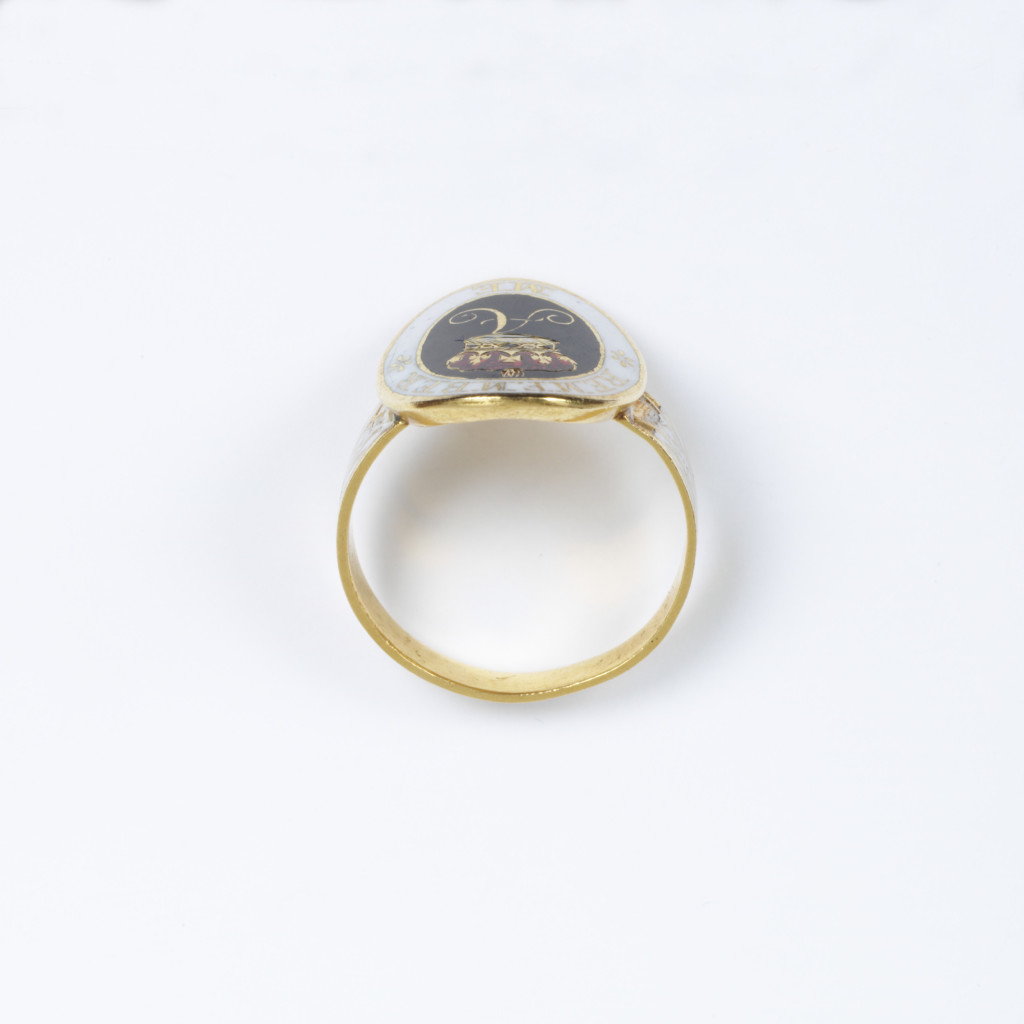
To deal the public mourning, the following happenings occurred:
“In consequence of a delay in sending an official notice of her Royal Highness’s death to the Dean of St. Paul’s, caused by the death of the Lord Chamberlain Lord Dartmouth, the custom of tolling the great bell at St. Paul’s did not take place till Sunday afternoon, November 4, immediately after a grand funeral anthem had been sung.” Gentleman’s Magazine for November 1810.
From November 5 orders were issued for a general mourning, and theatres and all other places of public amusement were closed till after the funeral (the 14th).” – The romance of Princess Amelia, daughter of George III (1783-1810) including extracts from private and unpublished papers
Mourning was not ordered until the 5th of November, three days after the death of Amelia and the Monday following the funeral. This general mourning period affected those at court and also cascaded down into society.
“But with all the pomp and paraphernalia of mourning the real chief-mourner was absent. There was no rightful place for the man who loved the dead Princess, who was betrothed to her, and whose bereavement far exceeded that of any of those who were bidden to make a show of grief. General Fitzroy is reported to have been ill, and it may well have been that he was so. He bore his sorrow in silence and alone, while the doleful pageant was being enacted in which he had no part.” – The romance of Princess Amelia, daughter of George III (1783-1810) including extracts from private and unpublished papers
What is clear from those who were close to Amelia and her death is that it was indeed a personal affair. George’s grief is clear in all texts and so is the silence that had befallen those who surrounded him. Mourning becomes not an ephemeral thing, but something that is an emotion. Grief and fashion are clearly two different things. While this ring may symbolise a style of jewellery that was contemporary and popular for its fashion, its grief is flowing through the fingers of its wearers.
Yet mourning is not simply the element that comes from death, but the moments of the immediate passing. Once there was life and then there is the unfortunate eventuality of the moment, mourning begins. In the case of Amelia, this was a custom and moved the idea of mortality closer to the home than a contemporary audience would normally allow:
“No proper state was kept up only 1 pair of candles two sofas made up as beds no refreshments prepared. Two maids sat up with the body. No pages or men-servants sat up, only women about the house. The duty was over at 8, and we left Windsor at half-past nine. The funeral is on Tuesday next. Lady A. C. as senior lady is to walk alone. All the ladies in long white crape veils and gloves. The men in dress coats…
“Princess A. gave a ring to… M[ontmolin] two days before her death. [The King] had been much distressed she gave nothing to the Q. It really made him miserable. When Miss Knight in her Autobiography says, “Two ladies sat up with the corpse every night until the time of the funeral. I was directed to perform this duty with Lady George Murray. We were in a room adjoining that in which was the coffin with the doors open. On the table was a book which had been a favourite with Princess Amelia. It was Tilikeper’s Thoughts on Religious Subjects, and many of them had a pencil mark.”
An extraordinary number of ornamental nails were put on the coffin of Princess Amelia.”
Insights into mourning fashion of the time can be seen in what is written about the ‘ladies in long white crape veils and gloves’ – this is the standard of the time. What modern perceptions of mourning and sentimental ritual began primarily in the 1840s, yet in the 1810s, there was a lot of movement about how fashion and identity were perceived.
With an understanding of the funeral and circumstance surrounding Amelia’s death and the writes of her funeral, it is important to look into the late 18th and early 19th centuries and how fashion and politics created an outcome that could establish such an event.
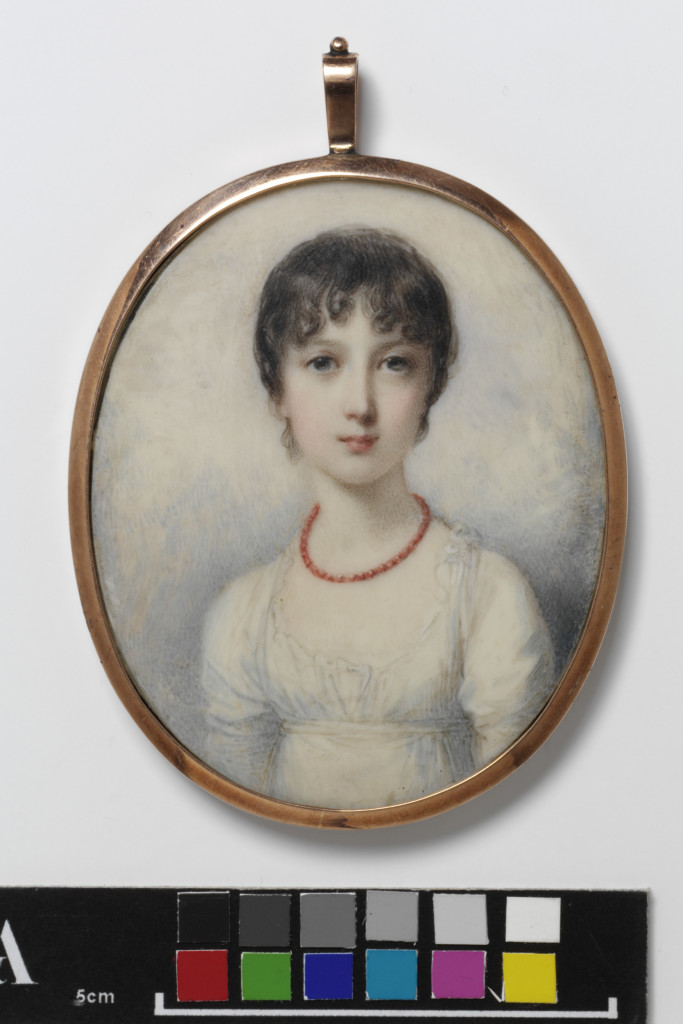
The 18th century welcomed in greater convention for mourning fashion and began to see the rise of the mourning industry. This became so much so that mourning dress was becoming desirable and the difference between mourning and non mourning dress was narrowing. Much of the fashion in this century was dictated by the fabric rather than the cut, and the silk industries in France and England held major influence on mourning wear because of this. It was Ordre Chronologique des Deuils de la Cour, (1765) where details of Court mourning in France were published, giving precise tailoring instructions. From their first days in mourning, men were permitted to appear in Court, unless it was after the death of a parent from whom they had received inheritance.
“‘dress was cut with a train and turned back with a braid attached to the side of the skirt, which was pulled through the pockets.’ This is where the overskirt is turned to the back and lifted up, revealing the petticoat underneath, called; robe retrousee dans les poche, the centre front robings were joined with hooks or ribbons. Cuffs were cut with one fold and deep hems, the waist was held in place by a crape belt that was tied on. This left two ends hanging down to the hem of the skirt. A woman’s accessories were a crape shawl, gloves, shoes with metallic bronzed buckles, a black woollen muff and a black crape fan. Head dresses of black crape and white batiste were referenced. For much of the century, however, ‘paniers’ were fashionable, but in the French style, with loose pleating falling from the shoulders to the back. The English manner of this was with the back pleats stitched down as far as the waistline. Also popular were lace ruffles at the neck and the cuff, embroidered stomachers, silver gilt lace, appliqué work and small aprons. None of these were permitted for mourning wear. Mourning wear for women still remained consistent in that it remained plain, black or sometimes white fabric” – Ordre Chronologique des Deuils de la Cour, (1765)
Widows had to wait one year and six weeks, with the first six months in black wool. Lord Chamberlain and Earl Marshall both ordered shorter periods of mourning in France and England respectively. By the 1880s in Britain, twelve weeks of mourning were ordered by the death of a king or queen, six weeks after the death of a son or daughter of the sovereign, three weeks for the monarch’s brother or sister, two weeks for royal nephews, uncles, nieces or aunts and ten days for the first cousins of the royal family. Foreign sovereigns were mourned for three weeks and their relatives for a shorter time. Mourning was divided up into First, Second and Court mourning.
Though there had been growing small scale social mobility from the late 17th century, the late 18th and early 19th centuries saw the middle classes having the opportunity to promote through society with the accumulation of wealth. Augustus Welby Northmore Pugin, a designer, architect and convert to Catholicism, saw this Industrial Revolution as a corruption of the ideal medieval society. Through this, he used Gothic architecture as a way to combat classicism and the industrialisation of society, with Gothic architecture reflecting proper Christian values. Ideologically, Neoclassicism was adopted by liberalism; this reflecting the self, the pursuit of knowledge and the freedom of the monotheistic ecclesiastical system that had controlled Western society throughout the medieval period. Consider that Neoclassicism influenced thought during the same period as the American and French revolutions and it isn’t hard to see the parallels.
In 1789, the French Revolution affected jewellery wearing and production to a great extent. The First French Empire under Napoleon retained and grew the popular Neoclassical styled jewels, maintaining their position as the primary leaders of fashion. Even with the hostilities between 1793-1815, the English closely followed Parisian styles.
By its very nature of wealth, jewellery was seen as a status symbol in France; an identifier for aristocratic status. During the Terror, the very possession of jewels or belt buckles may be enough to condemn one to the guillotine, while those who gave their jewels to the cause were seen as supporters and others simply hid theirs away for financial security if fleeing the country.
Jewels that were sold off following the Terror flooded the European market and dropped the prices of gems. In Paris, the only jewels to remain popular were souvenirs of the Terror itself. Simple iron relics inscribed with commemorations about the storming of the Bastille, or pieces containing stone or metal from the Bastille. Jewellery, by essence is a token. A reminder for memory to signify a time or a relationship in time that others can identify you by. When a culture suffers such a dramatic change, the utilisation of jewellery to promote a political message is not only important for the person’s connection to a community, but for their very safety itself.
In 1797, the Paris Company of Goldsmiths was reinstated, after being abolished in 1791, reintroducing many of the goldsmiths from the reign of Louis XVI. By 1798, hallmarking was established in France, making it compulsory to stamp jewels under three standards of purity; 750, 840 and 920 parts per 1000. They were also stamped with a maker’s mark (the maker’s or sponsor’s initial) and symbol in a lozenge-shaped stamp.
Filigree jewellery and fine detail to gold work had its inception here, as there was as shortage of money and goldsmiths became inspired by French peasant jewellery to produce finely detailed gold with lesser materials. Seed pearls, basic gems (such as agates) were also popular, as can be seen in the following pieces:
In the above, we can see how the fashion of fine gold and the access to seed pearls from the Orient made for highly detailed and inexpensive jewellery. Large enough to be seen and influenced by the Neoclassical style, this was a society adapting to the hardships that they were surrounded by.
This ring is the product of the use and popularity of the carnelian in jewellery. As these elements become popular, they resonate throughout society and here we see it with the intaglio inscription of ‘pietas’ in a swivel ring.
In 1804, the Napoleon’s Empire was announced and luxury trades were renewed with vigour. Bijoutiers, who worked in ordinary materials and joailliers, who worked in precious stones benefitted from this rise in luxury, with Napoleon requesting the jewels from the former kings of France to be set in the Neoclassical style, essentially connecting him to the Greco-Roman empires. His coronation crown was decorated with cameos and his passions for the antique world led him to establish a school of gem engraving in 1805. If ever there was a height for the Neoclassical period, it was this connection to it. How other societies would reflect this moment is seen in their contention or support of Napoleon. Here is a person who is appropriating the classical world in a time where it had been in mainstream thought and fashion for around forty years. International tension would only lead to the decline of this style, as cultures needed to obtain their own identities in jewellery fashion. A great push to the Gothic Revival style in England has its roots in this.
Simple designs and smaller jewels following in this early 19th century period. The geometric shapes, ovals, circles and rectangles became popular, with the Greek key pattern utilised often in jewels. It was about balance, with many patterns being taken directly from Greco-Roman architecture and detail. During this time, until his remarriage, Josephine was the bastion of style, maintaining the fashion which people would covet.
From this, what we see is that society had to adapt to the shock of the Terror and the new Empire, all the while other cultures are looking to France for its style and reestablishment. Greater and more literal influences of antique cultures led to the allegory of the sentimental depictions becoming literal interpretations of their architecture in jewels, making the individual the monument to classical art itself.
It cannot be understated how important the French influence upon sentimental jewels was in the turn of the 19th century. From the souvenir jewels stating such terms as “Souvenir d’amitié” and “Souvenir d’armour”, the statements of love that were worn on display created a new social proprietary that involved the use of sentimental jewels to offer admired people, within social circles, as signs of courtship and love.
Much of this sentiment stemmed from the French Revolution and its cultural challenge to established monarchy and religious value systems, particularly in the form of Liberté, égalité, fraternité (liberty, equality and fraternity). While the French Restoration of the first-quarter 19th century had repaired the monarchy itself, the challenge to established order had accomplished a lot to put new values in relationships and empower individuals. George IV encouraged society to look externally for artistic influence, since his ascendancy (and Regency, post Regency Act of 1811), George’s investment in the arts was required for the aristocracy to have these tokens of love as social requirements above simple affectations.
The Bourbons were restored in 1814, with jewels being more sedate in their designs due to the lack of wealth. Threaded seed pearl on horse hair created ornate bracelets and necklaces, with materials being smaller and more abundant to exaggerate their use. During the 1820s and 1830s, the use of cannetille (surface covered with wire) or grainti (small granules) embellished the colour of gemstones, as the gold was used in the base of the jewel. As seen with the portrait of Lady Peel by Sir Thomas Lawrence above, the wearing of several bracelets and enamelled rings on one finger elaborately exaggerated the colour of the jewellery. Classical style was starting to become overcome with elements of the Baroque and Rococo, which had only been popular previous to the Neoclassical period.
How this affected the mind of the early 19th century individual was a direct stylistic move away from what had bought about the unrest of the Neoclassical style. With competing styles being mixed for mainstream appeal, the classical style in its literal form would recede until the mid 19th century and the archaeological discoveries that would ignite it once more, such as Etruscan.
In the early 19th century, there was much to define the self through the identity of jewels. Neoclassical allegory had put the focus back upon the elements of the natural world which could contain their own symbolism. In the above image, the REGARD jewel is seen within the coiled serpent, denoting eternal love and piety. Given as a keepsake for a betrothed, all of the above jewels have a sentimental resonance, denoting futurity and an offering of new life and love.

Amelia lived and died at a time of modern social definition. Many of the elements that were taken from this time were indoctrinated by the Victorians and a lot of the industry, politics and values are still established today. From this article, we began with the basic nature of the ring and its design, then looked at the death of Amelia, which is what produced this ring. From a social perspective, we looked at the rest of the world and how a ring like this could be produced and identified as a mourning ring.
Jewels should never be taken for granted, they house the memory and love of an entire life. It is easy to generalise and conform a jewel to what a modern perception of it could be, or just take it for the basic value of being a simple metal token. From this ring we understand some of her values and those of her family and friends and that brings us one step closer to experiencing history.

The fourteenth child and ninth son of King George III and Charlotte of Mecklenburg-Strelitz, Prince Alfred was born on the 22nd of September 1780 and died on the 20th of August, 1782. As can be understood, his death at a young age incredibly affected his parents, affecting George III’s mental health. His brother, Prince Octavius, passed on six months later. The common thought of his death was the result of an illness after smallpox inoculation at eighteen months old. Alfred died at Windsor Castle and was buried at Westminster Abbey on the 27th of August, with the Dean of Westminster administrating the ceremony. His body was then taken to the Royal Vault at St George’s Chapel, Windsor on the 11th of February, 1820. Due to his age, there was no official mourning period for Alfred, but his death came at a time of the mourning industry being a necessary part of fashion and a self-sustaining one in its own right.
This locket is a token of memory for Alfred’s family, which shows that regardless of what society may impose, the feeling of grief and the fundamental principal of ‘mourning’ is in effect. There is sadness and love, with the desire to capture the thought of Alfred forever. One of the most affecting elements of this locket is the simple curl of hair in the reverse; there’s not enough hair to capture from the child to do an elaborate weave, just a simple cutting.
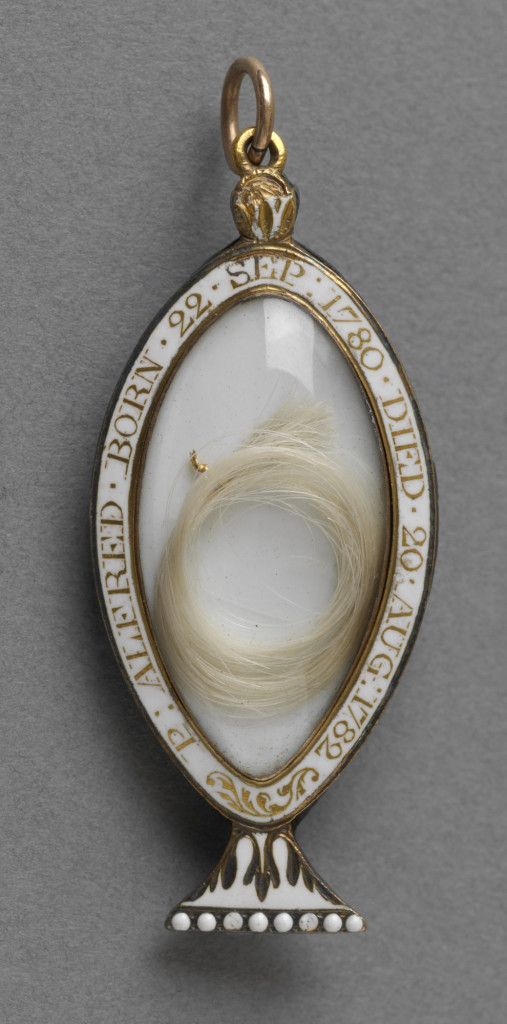
The locket shows the exact symbolism for the mourning of a child, perfectly encapsulated in the message of white enamel. Its reverse is spartan and white, putting more emphasis on the dedication and the hair itself. White enamel is the second most popular mourning material used, next to black enamel. Black enamel, being a colour that has represented death through to pre-history, was (and still is), the colour that was inlaid in jewels, most commonly with the ‘IN MEMORY OF’ sentiment. This was highly standardised by the 19th century, but in the 18th, there was much more flexibility with the use of sentiment and enamel colour.
Death, for its reasons of desecration and entrance into entropy, lead towards black, which in itself, is the absence of light. White, when in use, is the connection to purity, innocence and virginity, show the untarnished representation in colour towards a person’s morals and values. A young person who was not married was seen as unblemished in social status and the use of the white enamel to show this virtue is why white enamel is used in this context.
Colour and symbolism became the primary elements of the mid-18th century, with the introduction of the Rococo period and its infusion of naturalistic designs in jewellery. The previous Baroque period was notorious for its bolder, dominating design, however mourning jewels represent something far more personal than what could be reflected in grander statements of building and architecture.
Cost and the essential nature of wearing a mourning jewel requires that the wearer invest some intrinsic personal affectation into the jewel and that the jewel must reflect something of its time. The 18th century essentially established the industry of mourning, due in part to the Industrial Revolution and the rise of faster methods of production and a society which was becoming more and more mobile, with greater access to education and techniques. Alfred’s locket is constructed for royalty, which is the culmination of all the cultural influences that could be combined into one jewel. It has the potential to show all the artistic flourishes, which could define mourning as a statement, or simply show the personal nature of mourning for a grieving family member.
To see the evolution of artistic talent that made this jewel possible, one must look back to the previous century, where the basis of the industry began. In 1686, the revocation of the Edict of Nantes led to Huguenot goldsmiths and jewellers emigrating to Great Britain. This was when the previous allowance by Henry IV of France provided Calvinist Protestants (Huguenots) significant rights. With this retraction, the Huguenots bought with them skills which enabled the London trade to compete with Paris. This led to greater patronage with the influx of greater designs and new elements of fashion appearing as popular in jewels. By the mid 18th century, much of the values that were carried to Britain were instilled within the new industry and led to such elements as the Rococo designs in jewellery from its continental influence.
After this influx of Huguenot talent, the mourning industry grew along with jewellery development. Mourning rings were flourishing under a stabilised government that had not been seen under the Interregnum (Cromwell) period, as well as the new wealth that was developing from the burgeoning Industrialisation movement.

From the perspective of mourning iconography, this 1782 locket takes the primary ideal motif of the 18th century and turns it into the jewel itself. The urn is a motif that reached incredible heights of popularity in Neoclassicism due to its interpretation from the original classical depictions. It was a motif that was easily lifted from its source and fulfilled all the classical resonance that a revival period needed to convey the style of its respective era. With the focus back upon the personal nature of mourning and the departure of the direct link towards god, death itself became something worn prominently in mainstream fashion. The urn was a perfect way to show this, draped or undraped. Sitting on top of a plinth, column or tomb, the urn is often the central focus of the mourning depiction. The mourning character in the depiction (male or female) is often interacting with the urn in some way, either leaning against it weeping, sitting near it, standing beside it or looking at it directly. This links the personal nature of mourning from the person into the jewel itself. The mourner is the wearer or the person who created the dedication and the urn represents the loved one. Consider that; there’s a direct link in methodology of the urn to the self, this is why the urn is the central motif and not the mourner.
Usage of the urn had never wavered, however. Cremation of the body and the collection of ashes in the urn is a method that survived ancient civilisations well into the Dark Ages. The name itself is derived from the Latin ‘uro’, meaning ‘to burn’, so no matter what the shape of the vessel the title was always ‘urn’. This is a concept that never left the mainstream mind and its uptake as a Neoclassical symbol and its consistency as a funerary motif is simply a natural evolution for the urn’s depictions.
While burial became the more popular method of interment, the urn still retained its status as a symbol of death, testifying the death/decay of the body and into dust and the departed spirit resting with god.
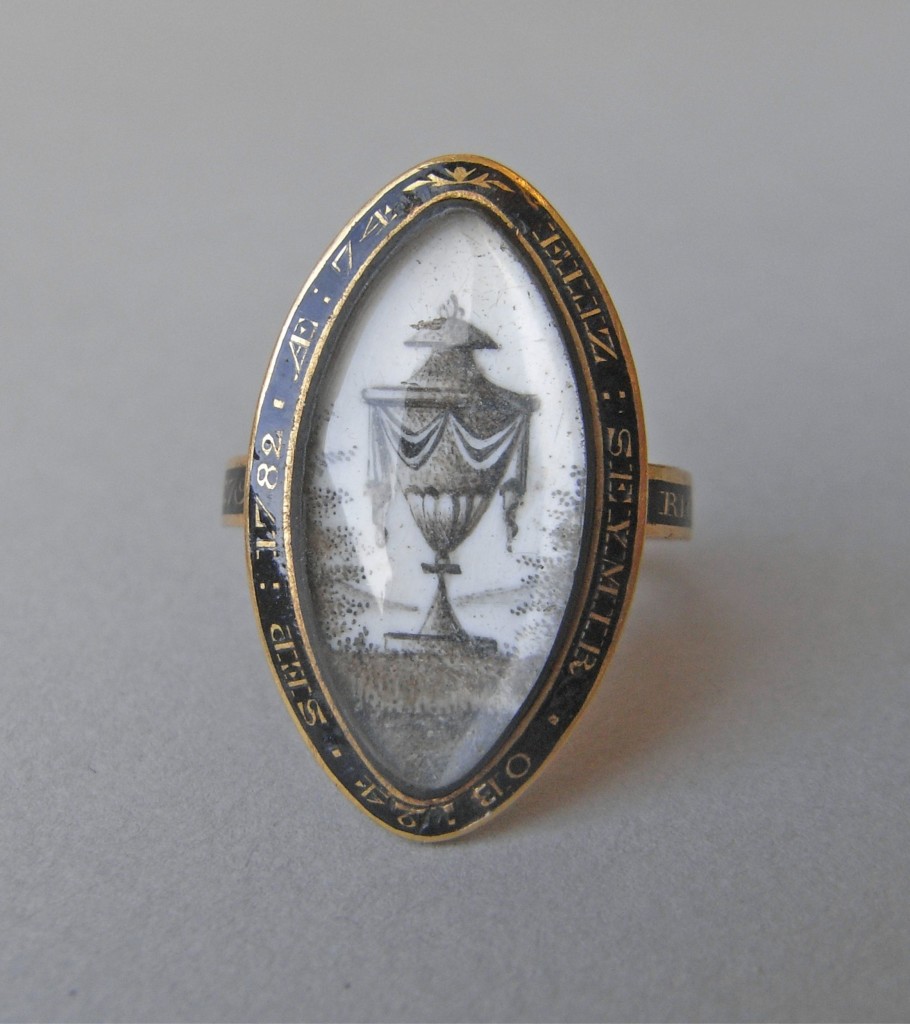
Draped urns are another variation of the popular symbol in the Neoclassical period. The draped urn itself often denotes the death of an older person, however, the drapery is often a constant when in relation to death. Interpretations of this can be when the shroud drapery denotes the departure of the soul towards heaven in relation to the shroud over the body, the drape is the partition between life and death or that it is guarding the sacred contents of the urn itself.
Alfred’s urn is constructed of amethysts and seed pearls, designed in a way to make the piece three dimensional to the viewer. It creates the volume of the urn’s shape through the width by bowing out the design in the convex ’navette’ shape around the sides. It is around the reverse where the white enamel is shown constructing the base of the urn and the hoop. These designs are subtle, but show drapery and fluid dimension to the locket.
Around the border of the urn is the inscription of:
‘P.ALFRED. BORN 22.SEP 1780 DIED 20 AUG 1782’
This was the bespoke element in all of the rings, lockets, clasps, brooches and pendants of the time. A skilled craftsperson could paint this to a specific style in the typography and deliver a jewel that seems perfectly made for the wearer. With many of the jewels in the late 18th century, the designs were created and then tailored to the request of the person who was purchasing the jewel. Much of this is due to the requirements of popular art and fashion.
When the styles become so large and so highly detailed, with miniature portraiture and allegorical scenarios taking popular place, the industry needed to accommodate affordable jewels. Dedications and designs are important to consider when looking at the level of quality in late 18th century mourning jewels, as the dedications can be very pristine and balanced with the art, others can be awkward in comparison. With the Alfred jewel in mind, the following contemporary jewels show the different ways that a jeweller could amend a design to accommodate the commissioned request:
Consider that the following style was popular in the 1770s:
And that the stark white background, typically ivory or vellum (later opaque glass) was the new canvas for the Neoclassical symbols to develop. The Neoclassical period was ushered in through the archaeological discoveries in Herculaneum and Pompeii, providing societies with genuine discoveries of societies locked in time. These classical symbols could be interpreted through jewellery, as seen in the putti/cherub placing the wreath upon hearts sitting upon the unbroken column. Symbolism was now taking the place of traditionally direct statements of love written inside a ring, or mortality being displayed through the memento mori visage of decay and death.
This piece, c.1782, shows how the style developed. In the 1770s, the styles were being pioneered and explored, with rings and pendants finding the shape/size of a canvas that would be most appropriate for the symbols. By the 1780s, it was large enough to accommodate the primary symbols of love and grief, in this case, sharing the urn and plinth, but having an idyllic design for them. This can be seen replicated in such jewels as:
In the above example, it shows how the urn and symbols were developing in 1776. Fashion was learning to adapt to the navette (pointed north to south) shape. Worn at the finger, neck or wrist, the shape perfectly conforms to the body, being ergonomically ideal for daily wearing (many have a convex reverse). With the above pendant, the style is carefully painted. The female character leans against the urn, with the willow awkwardly filling its space inside the border. The text is carefully written around the extremity of the piece, but doesn’t perfectly balance. When considered with the piece of today’s article and the 1782 piece above, this is a style that is still trying to discover a sense of conformity. Neoclassical art had permeated through countries and continents, being more conservative in Catholic regions, but still allegory was the key to identity. This piece doesn’t have the conformity of shape, either, something which would happen rapidly.
And in the above example, the navette style that was to become popular and the standard for wearable jewels of allegorical nature is seen to emerge. The sharpening of the mort hand the south of the piece, as well as more formal design to the urn and the willow allowed for more detailed dedications being painted on the canvas. The 1882 ring shows how this developed to its apex.
Pendants, however, of the larger sort, remained oval in shape. These were displayed, rather than worn, often in their own compact-destined velvet boxes. These sizes became typical in the 1790s, a time when the styles started introducing colour into the mourning depictions. The brown and darker red shades of the sepia colour (signifying body and earth) gave way to muted colour seen in the 1798 pendant. Note how the female mourner is in mourning fashion and there is the introduction of realistic colour, but the earlier sepia style is represented.
In this navette brooch from 1795, the colour representation in the background is unmistakable. Watercolour was leading into the colourful Neoclassical symbols; something that blurred the line between the popular portrait miniatures of the early 19th century and sentimental allegorical depictions.
One of the most common designs that work between these examples is the urn itself. The urn is the primary symbol of Alfred’s pendant and it was one of the most popular of the Neoclassical period. The symbol disappeared soon after the first quarter 19th century in mourning jewels, but was retained within funerary art. The Gothic Revival period played a key role in reverting society back to more ‘traditional’ values. Using a direct relation to the body in the urn conflicts with the burial/god connection which was part of the social understanding of life and death, that Christian values returned to a life under god.
You can find the urn in use to around the 1820s, but many of the latter uses in jewels are anachronistic in the same way that memento mori would have been during the late 18th century. However, in funerary, the urn was still retained and is to this very day. In fact, its use in architecture in the latter 19th century / early 20th century was quite typical, but it had largely disappeared as a motif to represent the self in mourning.
Why Alfred’s locket is so important is because of its status towards royalty and how other jewels cascade from that. It shows a level of wealth and investment that would be seen as a leader in style for others to imitate in 1782. Jewels of the late 18th century are opulent and large, relating closely towards fashion which was rapidly crossing through Europe as the aristocracy invested wealth in dressmakers, a level of artistry that could grow from this wealth, with travelling royalty and aristocracy presenting this fashion into new cultures. Death is never a trivial thing, which makes mourning fashion difficult to value as a cultural aesthetic, but it was something which could be dressed up within the periods of mourning. Death being an inevitability meant that courtiers could design or amend a dress to enter into mourning. In the case of Alfred’s death, there was no mourning period due to age, however the jewel shows a clear outpouring of love and grief into a token of memory.
Gems are the next element to consider in the Alfred locket. From the colour of the gem to the use of their application, this speaks to the affluence and personal sentiment locked in the jewel. This locket has amethysts, which are popular in mourning jewels, particularly from the third stage of mourning. Purple was an important colour for both sentimental and mourning purposes in jewellery of the 19th century, with its underlying meaning of love. This is a factor which became only more prominent as the 19th century wore on with sentimental jewels.
Amethysts were liberally used in mourning jewels of the 1780s, being a common gem that surrounded an oval shaped bezel, which usually held a sepia sentimental painting.
Associated with the Church, due to the the intrinsic connection through the colour purple (robes), amethysts are used in Bishop’s rings and crosses. The purple colour also allows for a third-stage mourning colour to be used in costume after the 1817 statement on Court Mourning by Lord Chamberlain. The religious connection here cannot be overstated, especially post 1840 and with the instillment of family values by Queen Victoria, following on from the Gothic Revival movement. A perfect amethyst should be deep purple and reflect colours of red when turned in the light.
In the post 1860 culture, violet was bought back into the post-mourning environment. First mourning lasted one year and a day, outdoor garments for this would be shown by the plainness and amount of crape, jet jewellery was permitted. After one year and a day, Second stage was introduced. This involved less crape and its application to bonnets and dresses became more elaborate. It was frowned upon if this period was entered into too quickly and it lasted nine months in all. The Third stage (or Ordinary stage), introduced after twenty-one months, involves the omission of crape, inclusion of black silk trimmed with jet, black ribbon and embroidery or lace were permitted. Post 1860, soft mauves, violet, pansy, lilac, scabious and heliotrope were acceptable in half mourning. This period lasted three months. The English Woman’s Domestic Magazine stated that ‘many widows never put on their colours again’ and this was quite a statement for the identity of the woman, which was held under the veil of mourning and family symbolism for the rest of her life. Hats, shawls, mantles, gloves, shoes, fans all changed during mid century, and pagoda sleeves from 1850-70 were fashionable, designed to be stitched to the outer sleeve to cover modesty from the lower arm and wrist. Wide skirts from the 1850s-70s, tie back fashions of the late 1870s and the ‘S-bend’ look of the early 1900s all were adapted to mourning fashion, without a clear definition of difference between them.
What this represents is that a colour used for love and piety could be bought back into the lexicon of fashion and love after a period of mourning, where it had been worn before mourning. While it was not necessarily something that social proprietary allowed to be bought back into daily fashion, the opportunity was there, as it was a colour designed for love.
Discovery and trade led to the desirability of pearls, particularly from medieval and Elizabethan times. ‘Oriental’ pearls, originating from the oyster family, were the most desirable due to their lustre, which pearls from freshwater mussels and conch shells do not have. The Oriental pearls were bought to Europe form the Persian Gulf by caravan traders.
The popularity of pearls reached their height in the late Georgian Era, where clusters of seed pearls were sewn to mother-of-pearl backs with cat gut, some examples can be seen below from the British Museum:
“Oval gold brooch with seed-pearls, in the form of a winged cupid with a lamb, on a base of mother-of-pearl, gesso or plaster; laid onto a background of blue enamel or blue glass and set under a domed glass cover in a gold mount within a pearl border. Inscribed in French.”
“Marquise-shaped pendant with seed-pearls, in the form of sheep and lambs under a tree, on a base of mother-of-pearl, gesso or plaster laid onto a background of blue enamel or blue glass and set under a domed glass cover in a gold mount with blue and white enamel and a tooled gold border. Compartment on reverse with plaited hair under glass.”
“Gold finger-ring with seed-pearls, in the form of a spray of flowers, on a base of mother-of-pearl, gesso or plaster; laid onto a background of blue enamel or blue glass under a domed glass cover in a gold mounted oval-shaped bezel with a pearl border.”
“Marquise-shaped pendant with seed-pearls, in the form of two birds carrying a knotted ribbon, flowers and wheat-ears, on a base of mother-of-pearl, gesso or plaster, laid onto a background of blue enamel or blue glass and set under a domed glass cover in a silver mount with a gold backing, with a border of pastes set in silver and a tooled gold inner rim.”
Seed pearls are a cultural element for Alfred’s locket, being fashionable and sentimental. Their use to create the urn shape on the front of the locket shows the detail of the size of the pearls, from large to small, creating the optical effect of dimension. It s a tribute to to artistry of the time and the access to materials which could allow for its construction.

When these elements are woven together, the narrative of this locket becomes clear. Fundamentally, it was made for a grieving family during a time of difficulty for the British Empire and resonates back into that difficult period by preventing the monarchy from having clear succession. The personality of a jewel is more important than its social and cultural impact, it’s a statement about attachment towards a loved one. Alfred died at a young age, an age that did not allow for the formalities of mourning to be implemented, so this jewel is essentially a piece of Alfred’s family.
Being the figurehead of solidarity, George’s children were seen in society as being the natural lineage of the United Kingdom. As such, the public interest in their lives was quite similar to the media coverage of today, with memorial items being made to commemorate their lives, be it a birth, wedding or death.
As such, it is important to look into the lives of these children and show the contemporary jewels that marked their lifestyles.





